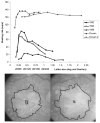Foveal-Sparing Scotomas in Advanced Dry Age-Related Macular Degeneration
- PMID: 20224750
- PMCID: PMC2836024
Foveal-Sparing Scotomas in Advanced Dry Age-Related Macular Degeneration
Abstract
Foveal-sparing scotomas are common in advanced dry macular degeneration (geographic atrophy). Foveal preservation may be present for a number of years. Despite good visual acuity, these patients have reduced reading rates. Magnification may not be effective if the text becomes too large to "fit" within the central spared area.
Figures





Similar articles
-
Reading newsprint but not headlines: pitfalls in measuring visual acuity and color vision in patients with bullseye maculopathy and other macular scotomas.Retin Cases Brief Rep. 2008 Winter;2(1):83-4. doi: 10.1097/IAE.0b013e31802fa25d. Retin Cases Brief Rep. 2008. PMID: 25389628
-
Fixation patterns and reading rates in eyes with central scotomas from advanced atrophic age-related macular degeneration and Stargardt disease.Ophthalmology. 1996 Sep;103(9):1458-66. doi: 10.1016/s0161-6420(96)30483-1. Ophthalmology. 1996. PMID: 8841306 Free PMC article.
-
Combined Fundus Autofluorescence and Near Infrared Reflectance as Prognostic Biomarkers for Visual Acuity in Foveal-Sparing Geographic Atrophy.Invest Ophthalmol Vis Sci. 2017 May 1;58(6):BIO61-BIO67. doi: 10.1167/iovs.16-21210. Invest Ophthalmol Vis Sci. 2017. PMID: 28475704 Clinical Trial.
-
The Progression of Geographic Atrophy Secondary to Age-Related Macular Degeneration.Ophthalmology. 2018 Mar;125(3):369-390. doi: 10.1016/j.ophtha.2017.08.038. Epub 2017 Oct 27. Ophthalmology. 2018. PMID: 29110945 Review.
-
The natural history of geographic atrophy, the advanced atrophic form of age-related macular degeneration.Mol Vis. 1999 Nov 3;5:25. Mol Vis. 1999. PMID: 10562649 Review.
Cited by
-
The Fovea-Protective Impact of Double-Layer Sign in Eyes With Foveal-Sparing Geographic Atrophy and Age-Related Macular Degeneration.Invest Ophthalmol Vis Sci. 2022 Oct 3;63(11):4. doi: 10.1167/iovs.63.11.4. Invest Ophthalmol Vis Sci. 2022. PMID: 36201174 Free PMC article.
-
Evaluation of Two Systems for Fundus-Controlled Scotopic and Mesopic Perimetry in Eye with Age-Related Macular Degeneration.Transl Vis Sci Technol. 2017 Jul 13;6(4):7. doi: 10.1167/tvst.6.4.7. eCollection 2017 Jul. Transl Vis Sci Technol. 2017. PMID: 28713647 Free PMC article.
-
Recent Advances in Imaging Macular Atrophy for Late-Stage Age-Related Macular Degeneration.Diagnostics (Basel). 2023 Dec 10;13(24):3635. doi: 10.3390/diagnostics13243635. Diagnostics (Basel). 2023. PMID: 38132220 Free PMC article. Review.
-
Living with Geographic Atrophy: An Ethnographic Study.Ophthalmol Ther. 2019 Mar;8(1):115-124. doi: 10.1007/s40123-019-0160-3. Epub 2019 Jan 31. Ophthalmol Ther. 2019. PMID: 30706242 Free PMC article.
-
Multimodal imaging and deep learning in geographic atrophy secondary to age-related macular degeneration.Acta Ophthalmol. 2023 Dec;101(8):881-890. doi: 10.1111/aos.15796. Acta Ophthalmol. 2023. PMID: 37933610 Free PMC article. Review.
References
-
- Fletcher DC, Schuchard RA. Preferred retinal loci: Relationship to macular scotomas in a low-vision population. Ophthalmology. 1997;104:632–638. - PubMed
-
- Gass JDM. Stereoscopic atlas of macular diseases. 4th. St. Louis, MO: Mosby; 1997.
-
- Green WR, Enger C. Age-related macular degeneration histopathologic studies: The 1992 Lorenz E. Zimmerman Lecture. Ophthalmology. 1993;100:1519–1535. - PubMed
-
- Hart WM, Burde RM. Three-dimensional topography of the central visual field: Sparing of foveal sensitivity in macular disease. Ophthalmology. 1983;90:1028–1038. - PubMed
-
- Lei H, Schuchard RA. Using two preferred retinal loci for different lighting conditions in patients with central scotomas. Investigative Ophthalmology & Vision Science. 1997;38:1812–1818. - PubMed
Grants and funding
LinkOut - more resources
Full Text Sources
Other Literature Sources
